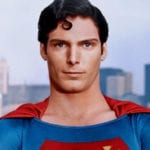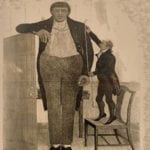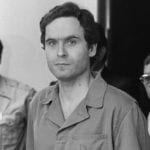 Weird Stuff
Weird Stuff  Weird Stuff
Weird Stuff  Our World
Our World 10 Ways Your Christmas Tree Is More Lit Than You Think
 Movies and TV
Movies and TV The 10 Coolest Stars to Set Sail on The Love Boat
 History
History 10 Things You Didn’t Know About the American National Anthem
 Technology
Technology Top 10 Everyday Tech Buzzwords That Hide a Darker Past
 Humans
Humans 10 Everyday Human Behaviors That Are Actually Survival Instincts
 Animals
Animals 10 Animals That Humiliated and Harmed Historical Leaders
 History
History 10 Most Influential Protests in Modern History
 Creepy
Creepy 10 More Representations of Death from Myth, Legend, and Folktale
 Technology
Technology 10 Scientific Breakthroughs of 2025 That’ll Change Everything
 Weird Stuff
Weird Stuff Ten Bizarre Facts About The Doge Meme
 Our World
Our World 10 Ways Your Christmas Tree Is More Lit Than You Think
 Movies and TV
Movies and TV The 10 Coolest Stars to Set Sail on The Love Boat
Who's Behind Listverse?

Jamie Frater
Head Editor
Jamie founded Listverse due to an insatiable desire to share fascinating, obscure, and bizarre facts. He has been a guest speaker on numerous national radio and television stations and is a five time published author.
More About Us History
History 10 Things You Didn’t Know About the American National Anthem
 Technology
Technology Top 10 Everyday Tech Buzzwords That Hide a Darker Past
 Humans
Humans 10 Everyday Human Behaviors That Are Actually Survival Instincts
 Animals
Animals 10 Animals That Humiliated and Harmed Historical Leaders
 History
History 10 Most Influential Protests in Modern History
 Creepy
Creepy 10 More Representations of Death from Myth, Legend, and Folktale
 Technology
Technology 10 Scientific Breakthroughs of 2025 That’ll Change Everything
10 Real-Life Inspirations For Characters In The Godfather
It’s one of the immutable laws of nature: You’re channel surfing, and there, between some cooking show and an infomercial, you come upon The Godfather. Even though you own the deluxe Blu-Ray DVD box set with three weeks’ worth of special features, you are glued to that station until the credits roll. And if it’s the first in a Godfather marathon, your day is shot. You’re not moving, except to warm up some frozen lasagna between Godfather 2 and Godfather 3.
The Godfather is a classic of American cinema, and Godfather Part 2 is considered by some an even better movie. This story of the patriarch of a New York crime family, and his son who takes over the “family business,” is largely based on Mario Puzo’s novel of the same name, with director Francis Ford Coppola and Puzo producing new material for the films.
Puzo based many of the characters on the real underworld players he heard about growing up and working in New York City.
10 Frank Costello
Inspired Vito Corleone

Don Vito shared traits with several mafia chieftains. The stealth and influence of Carlo Gambino, the most powerful mob boss of the ’60s and ’70s. The old-world demeanor of Joseph Bonanno. Like Joseph Profaci, Vito depended on his olive oil distributorship as a front for his illicit activities. And like both the Profaci and Bonanno crime families, the Corleones were small, insular, and powerful in their communities.
The Mafia boss most like Vito, however, was Frank Costello.
After the Castellammarese War, a bloody conflict between rival Italian and Sicilian gangs, Costello was instrumental in helping Lucky Luciano consolidate the sprawling Italian gangs of New York City into a “commission” of five separate crime “families.”
Costello served as the consigliere to the Luciano outfit—a respected counselor to the head of the family, as well as a liaison to other families and an arbiter of disputes. When Luciano was deported, his underboss and successor, Vito Genovese took over but soon fled the country. Costello, long-time “power behind the throne,” somewhat reluctantly took over as head of the family.
Costello, like Corleone, derived much of his strength from his influence with powerful political and business figures. He was known as “The Prime Minister” for his diplomatic skills, including, when necessary, graft and blackmail. Both the real crime boss and the fictional one preferred to fly under the radar, favored reason over bloodshed, and maintained a stance against “made men” dealing in narcotics. Both also survived public assassination attempts.
Finally, when Marlon Brando was researching the role, he listened to tapes of Costello talking to the Kefauver Committee on Organized Crime. Brando used Costello’s raspy tenor as his basis for Don Corleone’s voice.
9 Frank Sinatra
Inspired Johnny Fontaine

Not since Charles Foster Kane has a cinematic character been more transparently “lifted” from real life than Johnny Fontaine. Like Sinatra, Fontaine was a neighborhood boy made good, rescued from an unfair contract to a bandleader by a “friend” with underworld connections. And, like Fontaine, Sinatra’s career was rescued by his role in a war film (From Here to Eternity). Sinatra, however, did not have to resort to such a drastic measure as slipping a horse’s head between a studio boss’s sheets.
His connections to underworld figures, though, are legendary. Longtime FBI director and showgirl clothing enthusiast J. Edgar Hoover said Sinatra had a “hoodlum complex.” He certainly enjoyed playing the tough guy, and his associates often provided the muscle needed.
No one ever accused Sinatra of racketeering, but he was, at the very least, a muzzle-sniffing mobster groupie of the most devoted stripe. And, in spite of his disdain for the novel (he once spurned Mario Puzo when introduced at a restaurant, refusing to look up from his meal and calling him a “pimp”), he was briefly considered for the role of Vito Corleone, and reportedly had preliminary discussions with Coppola.
8 Willie Moretti
Inspired Luca Brasi

Frank Costello’s cousin was also his chief enforcer and was considered the “muscle” behind Costello. If not quite the legendary murderer-savant that Brasi was in the film and novel, Moretti, like Brasi did for Johnny Fontaine, reportedly stuck a gun into bandleader Tommy Dorsey’s mouth to get a young Frank Sinatra out of an unfair contract.
Less dour than the sociopath Brasi, Moretti joked his way through the Kefauver Organized Crime hearings (“What do you mean, like do I carry a membership card that says ‘Mafia’ on it?”) and generally enjoyed his mobster’s lifestyle. But his stand-up routine at the Kefauver hearings, and other increasingly erratic behavior, made some people nervous. Willie was said to be losing his mind, and becoming too talkative for the comfort of his bosses.
In what Vito Genovese labeled a “mercy killing,” Willie was executed after his lunch at Joe’s Elbow Room in New Jersey. He was shot in the face, the traditional mob sign of respect for the newly deceased.
Just as Brasi’s execution softened the Corleone Family for the rival Tattaglia and Barzini families, Moretti’s “elimination” was seen as a necessary component to loosening Costello’s grip on the Luciano-Genovese-Costello family, leaving it open to exploitation from Gambino Family.
7 Salvatore “Bill” Bonanno
Inspired Michael Corleone

The aforementioned Joseph Bonanno never wanted his son Bill to follow him in the family business, sending him to law school and pushing him in the direction of the “straight” life. But as he slowly inched his way in, he became more involved in the family’s crime operation, and took over as the ersatz COO of the Bonanno Family.
As an underworld leader, though, Bill was more Fredo than Michael. He was never accepted by the men on the street, and was seen as a puppet for the old man’s machinations. And unlike Michael, who moved with an uber-confident stealth and effectiveness that amazed even his father, Bill was pretty much an attention whore, stooge, and all-purpose muck-up. And unlike Michael, who steered his family through success in the straight world while maintaining influence in the underworld, Bill lived off the family nut and served as a producer or consultant for cheesy movies based on his “experience.”
6 Vito Genovese
Inspired Emilio Barzini

Where “honor,” to Don Corleone, was a salient life code, to Barzini, it was a fulcrum for manipulation. Both men were shrewd and focused, forward-thinking. But, unlike Don Corleone, Barzini cared little for the traditions of his culture, preferring to see things in terms of bottom-line efficiency, oblivious that what he disavowed as mere sentiment was, in fact, the fabric that kept La Cosa Nostra together and successful for so long.
Genovese was more brutal, less urbane than Barzini. But he was no less mercenary, and just as willing to let old-fashioned conceits take a back seat to business. Genovese, even though he decreed that narcotics were off limits to the men in his organization, was deeply involved in smuggling and distributing heroin and cocaine. And Genovese’s hubris, like Barzizni, led him to think of himself as the “Capo di tuti capi,” the “Boss of bosses.”
Though Genovese and Frank Costello worked within the same crime family, they were deeply suspicious of each other and grappled for control. Genovese was almost surely behind the assassination attempt on Costello. And Costello reportedly supplied authorities with information that ultimately sent Genovese to prison on drug distribution charges in 1959.
He tried to run his family from prison, with some success. But the lack of an “on the street” boss proved corrosive, and his family fell in power and influence. Genovese died in prison in 1969.
5 Bugsy Siegel
Inspired Moe Greene

In the Godfather universe, Moe Greene invented Las Vegas. In real life, it was Bugsy Siegel.
Siegel was an executioner for “Murder, Inc.,” the group of New York based killers, mostly Jewish and Irish, that the Italian mob developed to outsource some of their more sensitive work. He was later sent to Los Angeles to bring some control to the rackets there, and subsequently began hobnobbing with stars in Hollywood. He and George Raft were buddies, and he was known to hang out with Sinatra and Clark Gable.
He thought Las Vegas, at the time a sleazy town of threadbare card rooms and gin joints, could be transformed into a glamorous destination. History has proven him right.
Siegel called his old friend and partner Meyer Lansky, the mob’s “numbers guy,” and bankrolled his project. He spared no expense to build the Flamingo, a luxury casino and entertainment complex. He brought gaudy decorations, installed enough lighting to power a small town, and hired the most popular entertainers of the day. And the people came.
But revenues were slow in working their way back to Siegel’s backers. The outlay was enormous, but there seemed to be other issues. Lansky, it seems, was convinced his old pal was skimming, stealing money off the gross income, before it was reported. And Lansky, after several chances, reluctantly agreed that Siegel had to go. To Lansky, friendship was no competition for money.
On the evening of June 17, 1947, Siegel sat in the living room at the home of his mistress, Virginia Hill (whose long legs inspired the Flamingo’s name). An unknown gunman opened fire through the window, hitting Siegel multiple times. Though initially reported as being shot through the eye, he was actually hit twice in the face, and the pressure caused his right eye to pop out of its socket.
Moe Greene is killed less for financial misbehavior than embarrassing the Corleone family (he publicly slaps Fredo, his pupil in the casino business). But he suffers a similar fate. While getting a massage, he hears his name, puts on his glasses, looks up, and a bullet shatters the right lens of his glasses. The sight of blood flowing out of his eye socket is one of the most memorable in the film.
4 Tommy Lucchese
Inspired Philip Tattaglia
Though Lucchese wasn’t purely a “pimp,” as Vito described Tattaglia, his family was relatively small, and he needed to come to other families for influence and muscle.
In an effort to grow in strength and power, Lucchese broke with mafia tradition and allowed an associate, Vincent Papa, to smuggle and distribute heroin. Papa turned out to be a criminal visionary, and the profits, predictably, rolled in.
Papa was later sentenced to prison for his part in the French Connection drug thefts, and there he was stabbed to death in 1977.
Lucchese? Unlike nasty little Philip Tattaglia, who was gunned down in a hotel room with one of the prostitutes in his family’s employ, Lucchese used Papa’s organization and network to make a fortune in narcotics. He rose in stature within the mob, and died at the age of 67 of a brain tumor, one of the few members of La Cosa Nostra to have never spent a day in jail.
Sometimes, karma takes a day off.
3 Gaspare DiGregorio
Inspired Salvatore Tessio

DiGregorio, like Tessio, was a trusted captain in his crime family, enormously powerful within the Bonanno organization. But when Bonanno decided to promote his son, DiGregorio felt slighted. With the help of other mob bosses, including Gambino, Lucchese, and upstate boss (and Bonanno cousin) Stefano Magadino, DiGregorio plotted Bonanno’s ouster, and the “Banana War,” as the New York press called it, was on.
Tessio set up Michael Corleone for assassination at a “sit-down.” DiGregorio, newly appointed head of the Bonanno family, arranged an ambush at a similar meeting with the Joseph Bonanno faction. Unlike Tessio, who gets caught and “taken for a ride,” the DiGregorio men pulled off their attack, firing shots at the arriving Bonanno delegation.
Not a single shot hit its target. The Bonannos escaped.
The other bosses, presumably between bouts of laughter at DiGregorio’s sheer incompetence, kept him in place until they could find a replacement, after which he was retired, living in relative obscurity until passing away in 1970.
2 Meyer Lansky
Inspired Hyman Roth

“The Godfather, Part 2” introduces us to Hyman Roth, whose partnership with Don Vito was similar to that of Meyer Lansky to Lucky Luciano and Frank Costello.
The diminutive Lansky was a financial genius and as much responsible for the success of organized crime as anyone. Luciano, Costello, and others sought and valued his counsel.
Just as Roth reluctantly agreed to the assassination of his old friend and partner Moe Greene, so did Lansky realize the importance of Siegel’s execution. In the film, Roth utters the phrase “We’re bigger than US Steel,” a line long attributed to Lansky. And Roth’s primary liaison with Italian mob was a gangster named Johnny Ola, modeled on Vincent Alo, who performed the same task for Lansky. Ola was portrayed in the movie by Dominic Chianese, whose resemblance to Alo was striking, and who later went on to play Uncle Junior in TV mob series The Sopranos.
Unlike Roth, shot in an airport by Corleone operative Rocco Lampone, Lansky lived to see 80, in a modest south Florida community similar to Roth’s neighborhood in the film.
1 Joseph Colombo
Inspired Joey Zasa
The brash young boss in “Godfather, Part 3” bears immediate resemblance to John Gotti. Certainly, Gotti, at the time the film was being developed, was a media celebrity unlike any crime boss since Al Capone.
But Colombo, who took over the Profaci Family after Joe Profaci’s death, was the true Zasa prototype. He loved the limelight and took great care to whitewash his image. Like Zasa, he started an organization designed to focus on the positive aspects of the Italian-American community. Colombo’s Italian-American Civil Rights League was so strong that it succeeded in getting Paramount Pictures to make sure the word “mafia” was never used in The Godfather even as Colombo’s criminal machinations controlled the union labor used in the filming of the movie itself.
And, like Zasa, Colombo was shot in at his own organization’s unity rally, a public execution meant to send a message. In June of 1971, as The Godfather was filming in the same city, Colombo was shot by African American Jerome Johnson, disguised as a priest. Then another man stepped out of the crowd, shot and killed Johnson, then escaped.
Colombo had made some powerful enemies. Carlo Gambino was tired of Colombo constantly drawing a spotlight from the media and law enforcement. Within his own family, the Gallo brothers led by “Crazy” Joe Gallo battled for control of the organization. Crazy Joe, quite progressive for a mafiosi, had befriended several African Americans in prison, and many thought Johnson was a friend of Gallo’s prison buddies.
Colombo survived the attack, but lived seven more years paralyzed and semi-vegetative. He died in 1978.
Brent Sanders is a writer, musician, and free-lance shepherd who lives in a bomb shelter in suburban Appalachia. He occasionally rants about music, politics and sports at UberMullet.








